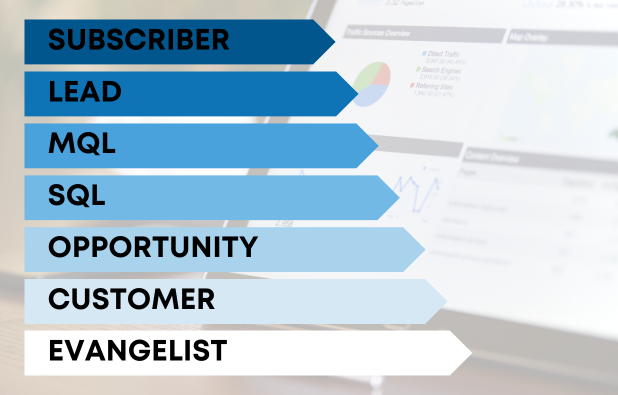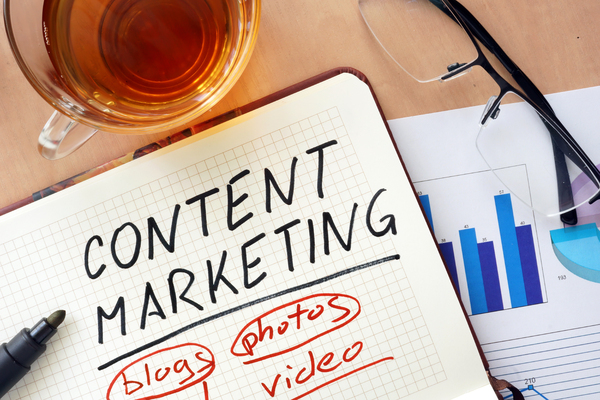The Marketers Guide to Content Marketing
Content marketing is about credible engagement with your audience. Simply put, content marketing is designed to connect companies and brands with...
7 min read
Inbound 281
May 22, 2023 8:30:00 AM EDT

HubSpot Lifecycle Stages play a crucial role in managing your contacts and optimizing your marketing strategies. By diving into this guide, you'll better understand how to leverage the HubSpot Lifecycle Stages for optimal results.
First, we'll explore the purpose and characteristics of each lifecycle stage. Then, learn how conducting thorough market research can help identify buyer personas and analyze customer pain points. Customizing HubSpot's default lifecycle stages to fit your business needs and streamlining prospect experiences to reduce friction during sign-up processes is essential.
In addition, discover the benefits of utilizing knowledge base software and including transparent pricing information with native payment options on your website. You will also learn about automating lifecycle stage triggers through workflows and segmenting contacts based on their respective stages for targeted marketing campaigns.
Finally, monitoring performance metrics will allow you to make data-driven decisions while training your team on best practices ensures seamless collaboration between departments when working with HubSpot Lifecycle Stages.
To implement best practices, it's crucial to understand the different lifecycle stages in HubSpot clearly. These stages include Subscriber, Lead, Marketing Qualified Lead (MQL), Sales Qualified Lead (SQL), Opportunity, Customer, Evangelist, and other. Knowing each stage's purpose and characteristics is essential for optimizing your marketing efforts.
Subscriber: Individuals who have signed up for your email updates or newsletters.
Lead: Contacts who have shown interest in your products/services by completing a form or downloading content.
MQL: Leads that meet specific criteria based on their engagement with your marketing activities.
SQL: MQLs deemed ready for direct sales follow-up after further qualification by the sales team.
Opportunity: Contacts actively engaged in the buying process with a high likelihood of converting into customers.
Customer: Contacts who have made a purchase and are now customers.
Evangelist: Customers who are highly satisfied and actively promote your brand.
Other: Contacts that do not fit into any of the default lifecycle stages.
It's important to note that these default lifecycle stages can be customized to fit your business needs. You can also sync lifecycle stages with your CRM to ensure consistency across your sales funnel and opportunity stages.
Understanding HubSpot Lifecycle Stages is critical to any successful inbound marketing, sales, and service strategy. To ensure success with these strategies, it's important to conduct thorough market research to identify buyer personas and analyze customer pain points.
Before setting up your HubSpot lifecycle stages, conduct comprehensive market research to identify your target audience segments and their unique needs. This will enable you to create more targeted communications for prospects at each stage.
Identifying buyer personas: Develop detailed profiles of your ideal customers, including demographics, interests, and pain points. Use tools like Definitive Buyer Persona Kit.
Analyzing customer pain points: Understand your target audience's challenges through surveys or interviews to provide tailored solutions addressing their concerns.
Conducting thorough market research is essential to identify the buyer personas and analyze customer pain points in order to create a successful marketing strategy. To ensure your efforts are effective, customize lifecycle stages for your business by adapting default stages based on industry or niche and creating additional custom lifecycle stages if needed.
To ensure your marketing efforts align with your customer's journey, it's essential to tailor the default HubSpot lifecycle stages according to your company's specific sales process. This involves:
Adapting default stages based on industry or niche: Modify existing stages to better suit the unique characteristics of your target audience and market sector.
Creating additional custom lifecycle stages if needed: If necessary, add new stages that reflect distinct steps in your customer journey not covered by HubSpot's default options.
This customization will enable more targeted communications for prospects at each stage, ultimately improving lead conversion rates and overall ROI. HubSpot's lifecycle stages are an essential part of the sales funnel, allowing you to track a contact's and opportunity stages. You can easily monitor and analyze your sales pipeline by syncing lifecycle stages with your HubSpot account.
Customizing lifecycle stages for your business can help you maximize the effectiveness of inbound marketing, sales, and service efforts. Streamlining the prospect experience is a key step to creating an efficient customer journey that leads to conversions.
To effectively guide prospects through the sales funnel, it's essential to simplify their experience at each HubSpot lifecycle stage. This can be achieved by reducing friction during sign-up processes and offering personalized recommendations based on user behavior.
Reducing friction during sign-up processes: Simplify forms, only requesting necessary information. Consider using social media logins or single sign-on (SSO) options for a seamless registration experience.
Offering personalized recommendations based on user behavior: Utilize HubSpot's analytics tools to track prospect interactions with your content and provide tailored suggestions catering to their needs and interests.
By streamlining the prospect experience, marketers can reduce friction during sign-up processes and offer personalized recommendations based on user behavior. Knowledge base software is a great way to address frequently asked questions effectively while providing self-help resources 24/7.
Implementing HubSpot's knowledge base software allows you to create an extensive resource library addressing common questions from leads across all lifecycle stages. This increases efficiency within your teams and empowers prospects with self-help resources available 24/7.
Create a comprehensive FAQ section covering key topics relevant to each lifecycle stage.
Promote this resource through targeted email campaigns and on-site navigation menus for easy access.
Incorporate informative articles, video tutorials, and downloadable guides that cater to the unique needs of your audience at different stages in their journey with your business.
Utilizing knowledge base software can help streamline customer service, providing quick and accurate responses to frequently asked questions. Incorporating pricing info and native payment methods on your website can help to improve the customer experience further.
To optimize your HubSpot account, ensure that potential customers can easily access pricing details about the products or services offered. Make this information readily available on your website or through email campaigns targeted at specific lifecycle stages where such data becomes relevant.
Display transparent pricing structures: Providing clear and easy-to-understand pricing helps build trust with prospects, increasing the likelihood of them moving forward in the sales funnel.
Integrate secure and user-friendly payment methods: Consider incorporating native payment options for seamless transactions, such as using HubSpot's built-in Shopify integration.
Including pricing information and native payment options can help streamline the sales process, while automating lifecycle stage triggers will ensure that customers are provided with a smooth customer experience.
Utilize HubSpot's automation features to automatically move prospects from one stage to another based on their interactions with your content. This will save time and effort while ensuring accurate tracking of lead progression.
Create workflows in HubSpot that define the criteria for transitioning contacts between lifecycle stages, such as downloading a specific resource or submitting a form.
Analyze the performance of your automated triggers regularly, making adjustments as needed to optimize the sales funnel and improve conversion rates at each opportunity stage.
By automating lifecycle stage triggers, you can ensure your customers receive the most relevant and timely content for their current position in the customer journey. With this knowledge, you can segment contacts based on their lifecycle stages to craft more targeted marketing campaigns.
Segmentation is key in providing personalized communications tailored to each prospect's needs within the current contact's lifecycle stage. Use HubSpot's contact management tools to segment contacts accordingly, allowing you to send more targeted messages that resonate better with recipients.
Create segmented lists by industry or persona. Group your contacts based on specific industries or buyer personas for more effective marketing campaigns.
Craft customized marketing campaigns per segment. Design unique email templates and content offers for each segmented list, ensuring higher engagement and relevance.
By segmenting contacts based on lifecycle stages, you can ensure that your marketing campaigns are tailored to the right audience. It's essential to observe and evaluate performance data in order to modify tactics for peak achievement.
To optimize your marketing efforts and maximize ROI, continuously tracking performance metrics across all HubSpot lifecycle stages is essential. This enables businesses to identify areas needing improvement and adjust strategies accordingly.
Conversion rates by life cycle stage
Email open and click-through rates
Social media engagement metrics
Website traffic sources and user behavior patterns
Analyze the data collected from KPIs to make informed decisions about which tactics are working well, where improvements can be made, or if new approaches should be explored. Remember that ongoing analysis is crucial for long-term success in your HubSpot account.
By examining and assessing performance indicators, marketing managers can acquire precious knowledge regarding the success of their plans. With this knowledge in hand, they can then move on to training their team on best practices for optimizing customer experiences across all lifecycle stages.
To maximize the effectiveness of your HubSpot account, it's essential to train your team on best practices for managing and utilizing HubSpot lifecycle stages. This will ensure everyone involved understands how these stages apply specifically within the context of your organization's structure and culture, ultimately driving higher levels of success throughout the entire process.
Provide ongoing training resources: Offer regular workshops, webinars, or online courses covering lifecycle stage management and optimization topics.
Encourage collaboration between departments: Foster a collaborative environment where marketing, sales, and customer service teams can effectively leverage HubSpot's lifecycle stages for improved results.
The lifecycle stages in HubSpot represent the different phases a contact goes through during their interaction with your business. These include Subscriber, Lead, Marketing Qualified Lead (MQL), Sales Qualified Lead (SQL), Opportunity, Customer, and Evangelist. Each stage helps you understand where a contact is in their buyer's journey and tailor marketing efforts accordingly.
Lifecycle stages can be set manually or automatically using workflows within HubSpot. To automate this process, create a workflow that sets specific criteria for each stage transition based on user behavior or lead scoring. This allows contacts to move through the funnel seamlessly as they meet predefined conditions.
The product life cycle refers to the four main phases of a product's existence: introduction, growth, maturity, and decline. HubSpot usage involves utilizing various tools like CRM management systems and inbound marketing strategies throughout these phases to maximize customer engagement and drive sales growth.
The five key stages of the customer interaction lifecycle consist of Awareness - when potential customers first learn about your brand; Consideration - prospects research options before making purchase decisions; Conversion - leads become paying customers; Retention - keeping existing customers satisfied; Advocacy - turning loyal customers into promoters who recommend your products/services to others.
Understanding HubSpot Lifecycle Stages is essential for any marketing manager or specialist looking to optimize their sales funnel. By implementing an integrated approach to your marketing strategy, you can maximize the number of leads generated and increase conversion rates by providing a unified experience for prospects throughout their journey.
If you're ready to take your inbound strategy to the next level with HubSpot Lifecycle Stages implementation that delivers results, contact Inbound 281 today!

Content marketing is about credible engagement with your audience. Simply put, content marketing is designed to connect companies and brands with...

Are you looking to increase your marketing strategy's effectiveness? If so, you're not alone. With the vast array of marketing channels and...

A marketing implementation plan is a critical component of a comprehensive marketing plan, providing a clear roadmap for executing marketing...